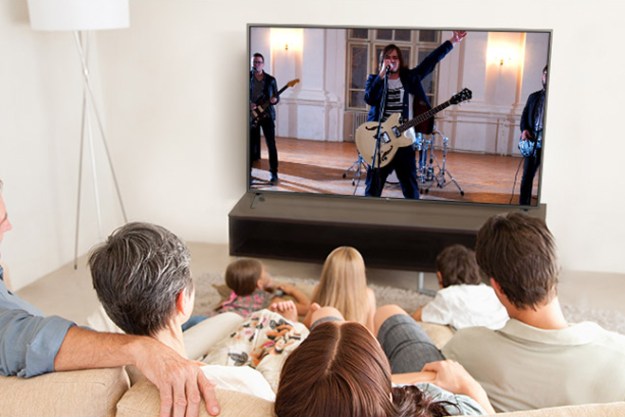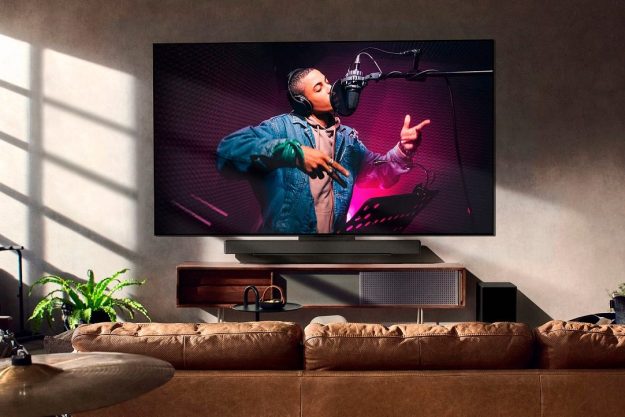
With technology evolving at such a rapid pace, buying a new TV can be an intimidating proposition. After all, no one wants to invest in a high-definition television that’ll be outdated by the time you take it home and plug it into the wall. Complicating matters is all the confusing jargon thrown around, be it 1080p, 16:9, HDMI, ATSC, 120Hz and Blu-ray. Huh? You probably — and justifiably — feel like you need a degree in electrical engineering just to understand it all. And then there’s the sheer number of choices at retail. Take a stroll into your local retailers and you’ll stare at a sea of never-ending television sets. How on earth do you know which one to buy?
While manufacturer, screen size and technology (e.g. LCD, plasma) boils down to personal preference (and budget), perhaps we can help isolate some of the worthy features to look for when you’re shopping for your first (or next) HDTV
 Full HD (1080p)
Full HD (1080p)
A high-definition television is capable of displaying up to 1,920 vertical pixels by 1,080 horizontal pixels on its widescreen display (often referred to as 16:9 format). This translates to a lot more detail and clarity than the older “standard definition” televisions, which have fewer pixels, are and shaped more like a square. Now, you might see an HDTV today referred to as a “Full HD” or “1080p” television, meaning all the lines of resolution are shown “progressively,” or displayed in sequential order, in a single pass (1, 2, 3, etc.), opposed to the older 1080i (“interlaced”) method of alternating between even and odd lines to make up the image (1, 3, 5, etc.). This results in a smoother, richer picture, if connected to a 1080p source, such as a Blu-ray Disc player or high-definition video game console. Buying a 1080p future-proofs your investment.
 LED backlighting
LED backlighting
Until recently, there was a discernible advantage for plasma over LCD TVs when it came to contrast ratios – the difference between the brightest whites and the blackest blacks displayed by the television – but this gap has been bridged considerably with something called LED backlighting. This LCD-embraced technology places light-emitting diodes behind the liquid crystals, resulting in high brightness, darker blacks and for more vivid colors. LED backlit TVs cost more than regular LCD TVs, sure, but are preferred among movie lovers. When looking at black on a LCD TV without LED backlighting, it might look more grayish, as there’s a light on behind the pixel.
 120Hz, 240Hz
120Hz, 240Hz
This popular LCD TV-based technology helps reduce motion blur. Pronounced “120 hertz,” 120Hz technology essentially doubles the speed at which frames are displayed, from 60 frames per second to 120 frames per second, resulting in a clearer moving image, especially in fast-action video sequences. Sony, by the way, often refers to this technology as MotionFlow. Some LCD TVs now offer 240Hz motion technology, which — yep, you guessed it — quadruples the 60 frames per second video source. Not everyone is sold on 120Hz/240Hz technology, so it’s best to see it for yourself at the store before you buy into it. And plasma TV shoppers need not worry about this as plasma TVs handle motion well, natively.
 Widgets
Widgets
Many of the top television manufacturers – including Sony, Sharp, Panasonic and Samsung – include Ethernet jacks on the back of their premium televisions for high-speed Internet connectivity (or in some cases, have integrated Wi-Fi for wireless connections). TV viewers will then use the remote to select “widgets,” graphical icons on the screen that plays relevant (and customized) content ranging from YouTube videos and Flickr photo galleries to local weather, news, sports updates and stock quotes, usually delivered by Really Simple Syndication (RSS). Even more exciting is the partnership between Netflix and various TV companies, such as LG and Sony, allowing television viewers to access tens of thousands of movies on-demand, many of which are in high-definition.
 ATSC tuner
ATSC tuner
While most TVs have a built-in NTSC tuner (National Television Standards Committee), the same video standard used by the television industry in North America (and some Asian countries) over the past half-century or so, newer TVs might also house an integrated ATSC tuner. This stands for Advanced Television Systems Committee, and is a handy addition to your TV as you can receive many free over-the-air high-definition broadcasts (depending on where you live). Some HDTV owners don’t subscribe to a television provider’s service at all, and instead, pick up these HD signals over the airwaves.
 HDMI, USB, memory cards and more
HDMI, USB, memory cards and more
A final consideration when buying a new HDTV is what you can connect to it. Make sure there are ample HDMI (High-Definition Multimedia Interface) ports to connect multiple components, such as a cable/satellite receiver, video game consoles, DVD/Blu-ray player, camcorder, and so on. At least three or four such ports is a must. A convenient bonus is when the TV also offers a USB port to connect a Flash thumb-drive or external hard drive full of music, photos and videos, or a SD or Memory Stick card slot that lets you insert a compatible card that contains photos and videos. If you think you’d like to connect your computer to the television for big-screen web surfing, look for one with PC connectivity. Many TVs today offer these additional features.
 Full HD (1080p)
Full HD (1080p) LED backlighting
LED backlighting 120Hz, 240Hz
120Hz, 240Hz Widgets
Widgets ATSC tuner
ATSC tuner HDMI, USB, memory cards and more
HDMI, USB, memory cards and more

